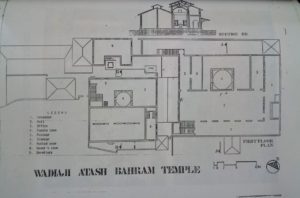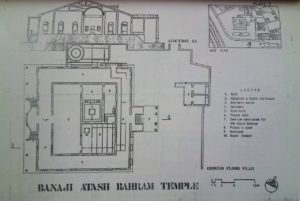—–By Heritage Architect Sanaeya Vandrewala
Fire Temple —Aatash Bahram, Agiaries & Dadgahs
“O Ahura, Thy Divine Fire

A DEPICTION.
Grown mighty through Asha, do we earnestly desire!
Swiftest of the swift, supremely powerful,
Giving clear help, at all times, to the faithful.
But Mazda, Thy fire shall see through and annihilate,
With a turn of the hand, the evil and their hate.”
[Gatha Ahunavaiti, Yasna 34.4]Fire in Zoroastrianism is the center for worship. It is a Zoroastrian belief that through veneration of fire one can create an intimate communion with God, who is the creator of this sacred fire. It is the third holy immortal and has a religious significance of being a symbol of righteousness. Prophet Zarathushtra mentions fire as the holiest of the elements to be worshiped as the source of heat, light, life and growth. He selected it as a symbol of his faith to symbolize the divine spark within. Fire, in Zoroastrianism therefore, is considered one of the most sacred elements of nature.
In ancient times, Zoroastrians had no fixed place of worship. It was in Achaemenian times, during the reign of Darius I (522-486 BC) that permanent altars were built as a place for worship. The earliest places of worship were probably sanctuaries founded by kings and nobles dedicated to Bahrām the Yazata for victory. Fire altars on stone platforms were built during Achaemenian (550 BC- 330 BC) and Sassanian times (224 AD -652 AD) and depicted in inscriptions, carvings and coins. Congregational ceremonies took place under an open sky, where the worshipers gathered. The most sacred fires were placed in secluded areas.

The western world has wrongly interpreted Zoroastrianism to be a fire-worshiping cult. The concept of the element of nature was confused, by the general population, with that of the spirit that resides within it. Fire occupies an important place amongst the elements in the religious system of Zoroastrianism. Such veneration should not be misunderstood as deity worship, as the religion is monotheistic in its belief and similar homage is paid to the other elements of nature.
There are three grades of consecrated fire in India, based on the level of the consecration of the fire enthroned in the sanctum sanctorum.


1. Aatash Bahrām (Top-most grade of Fire-Temple) :
An Aatash Bahrām is the highest grade of fire with the highest level of consecration. It is consecrated through elaborate purification ceremonies performed by Mobeds (priests). Fire from sixteen different sources are collected, purified and used after 14,000 hours of prayer ceremonies. This fire is then enthroned in the sanctum sanctorum of the Aatash Bahrām. The entire process is well spanned over a period of 18 months. Hence the Aatash Bahrām fire is no ordinary fire, but the one kindled into existence through the performance of extraordinary series of complex rituals.
| Sr.no | Kinds of fire | No of times for the basic collection, purification and consecration process |
| 1 | Fire of a burning corpse | 91 |
| 2 | Fire of a dyer | 80 |
| 3 | Fire of a king or ruling authority | 70 |
| 4 | Fire of a potter | 61 |
| 5 | Fire of a brick maker | 75 |
| 6 | Fire of an ascetic | 50 |
| 7 | Fire of a goldsmith or alchemist | 60 |
| 8 | Fire of a mint | 55 |
| 9 | Fire of an ironsmith | 61 |
| 10 | Fire of a maker of armors | 61 |
| 11 | Fire of a baker | 61 |
| 12 | Fire of a brewer | 61 |
| 13 | Fire of a soldier or traveler | 35 |
| 14 | Fire of a shepherd | 33 |
| 15 | Fire atmospheric electricity(lightning) | 90 |
| 16 | Fire of a Zoroastrian (a fire kindled through friction by a Dastur and Mobed one each and these are then mixed with a Behdin (non priest) | 184 |
| 1128 times |
Above Table Source: Dr. Sir J.J Modi, The religious ceremonies and customs of Parsees
The existing Aatash Bahrams in India:
- Iranshah established in Sanjan in 855 AD and then finally moved to Udvada in 1742 AD, where it has stood since then;
- Anjuman Atash Bahram in Navsari (1765 AD )
- Dadyseth Atash Bahram in Mumbai (1783 AD )
- Modi Atash Bahram in Surat (1823 AD)
- Vakil Atash Bahram in Surat (1823 AD)
- Wadia Atash Bahram in Mumbai (1830 AD)
- Banaji Atash Bahram in Mumbai (1845 AD)
- Anjuman Atash Bahram in Mumbai (1897 AD)
- Atash Adaran (The next grade of Fire-Temple):
The fire in an Atash Adaran is consecrated with fewer rituals and is peculiar to the Parsi Zoroastrians. Such fires are installed in Agiaries (Sanskrit for ‘House of Fire’). This fire must be kept perpetually burning and is therefore tended by a priest at Boi ceremonies five times a day. There are hundreds of such Adarans in India with the maximum number in Mumbai. The oldest is in Navsari, installed in 1150 AD. There are no Atash Adaran fires anywhere else in the world.
- Atash Dadgah (the third grade of Fire -Temple):
This is the third grade of fire. Its consecration is simpler as compared to the first two. This fire temple is often called a Dar-e-Meher. The Atash-e-Dadgah can be touched by both a priest and a layman but not a non-Zoroastrian.
The Architecture of Fire temples in India
Between the 18th and 19th centuries, seven Atash Bahrams and hundreds of Adarans and Dadgahs were built in India reflecting the prosperity of the Zoroastrian populace. All temples are based on the triadic principle. Hence the entry from an outer portico would have a corridor adjacent which is used for basic rituals and kusti prayers before entering the assembly hall and inner prayer hall. The passage adjacent to the portico acts as transitional space between the outside and the prayer hall to preserve the sanctity of hall.

The inner chamber, where the sacred fire is installed, is a square room surrounded on three sides by the prayer hall. The southern side is a dead wall, to ensure the devotees do not face the north during prayers. This is done based on the religious belief that the ‘evil’ resides in the north, hence the architectural proscription. Niches are built into the walls for ritual purity. The other three sides of the inner chamber have openings to facilitate the view of the sacred fire during prayer ceremonies, once, inside the fire temple, the prescribed Zoroastrian mandate to face east when praying is prescribed; one must face the consecrated fire when praying. The inner chamber or sanctum sanctorum has only one door for entry and exit.

The floor is generally covered with hard basalt stone, demarcated by three sets of furrows, known as ‘Pavis’ in Gujarati. The sacred fire is placed within the innermost area marked by furrows. Generally, the sanctuary is domed, with flues cut into it to facilitate the exit of smoke generated by the fire. In most of the cases the dome is a false ceiling to the pitched roof that is supported by the masonry.
Every fire temple must have within its complex, an open well that is fed by freshwater springs and should include a pomegranate tree and a date tree. The leaves of these trees are used during rituals performed during various religious ceremonies. The fire temple complex also has a place of residence for priests who serve the fire (‘Boiwalas’).
With the decline in population, the question of the continued use and maintenance of these places of worship has arisen. With no population to tend to or serve in certain areas, the community is faced with the challenge of the future existence of these structures.
References:
Godrej, P and Mistree, P (Ed) (2002) A Zoroastrian Tapestry: Art, Religion and Culture. Ahemdabad: Mapping publishing Pvt Ltd.
Masani (2001, 86) Masani,R (2001)The religion of the good life Zoroastrianism. London: George Allen and Unwin Ltd.
Mistree,K (1982) Zoroastrianism : An ethnic perspective. Bombay: Khojeste P. Mistree
Motafram, R (1984) Zoroastrianism Vol III: Light on Zoroastrianism. Mumbai: The trustees of the Parsi Punchayat funds and properties, Bombay.
Rivetna,R (Ed) (2002) The legacy of Zarathrushtra:An introduction to religion , history and culture of the Zoroastrians. Illinois: Federation of Zoroastrian association of North America
]]>